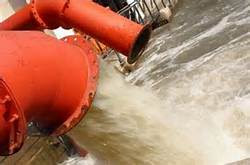Sewage in
Freshwater Ecosystems
Effects of sewage in freshwater ecosystems
Dumping
sewage into water bodies, such as rivers or lakes, creates a human health
hazard but can also negatively disrupt the river and lake ecosystems.
The
sewage contaminates the water, spreads disease, and leads to environmental
degradation.
Here
is a list of effects of untreated sewage disposal into freshwater ecosystems:
 1. Increased organic matter (from the sewage)
breaking down in the river reduces the amount of dissolved oxygen in the water
body as the decomposition process uses up the available dissolved oxygen. Fish
and other aquatic life need that dissolved oxygen in the water to live.
1. Increased organic matter (from the sewage)
breaking down in the river reduces the amount of dissolved oxygen in the water
body as the decomposition process uses up the available dissolved oxygen. Fish
and other aquatic life need that dissolved oxygen in the water to live.
2. Sewage heightens the levels of nutrients,
increasing the bioavailability of nutrients, which can increase productivity of
plankton near the sewage outfall and increase the chance of algal blooms.
3. Contaminants present in the sewage might
be toxic for some already existing phytoplankton.
4. Sewage can increase the turbidity and
amount of suspended sediments. This effect reduces light available for plant
growth, can smother in-stream habitats, and damage fish gills and respiratory
structures of other species.
5. Sewage (and stormwater runoff) can
introduce pesticides, other chemicals, and heavy metals into the water column.
It may also introduce fine sediments, which have the potential to
(bio)accumulate within animal tissues and have long-term toxic effects. Sewage
and run off may increase acidity, such as from acid sulphate soils
which kill fish and crustaceans, cause fish red-spot disease, damage or cause
death of oysters, and interact with sediments to release heavy metals.
6. Industrial effluents (often a complex
mixture of chemicals) can negatively affect fish by impairing growth and
reproduction and by reducing immune competence. These effects have the potential
to impact fish populations.
7. Microbial pathogens introduced by sewage
into surface or groundwater can threaten public health, as well as affect
ecosystem health and function.
8. Sewage can release water that is either
warmer or cooler than the receiving water body. Because aquatic life has
optimal temperature ranges within which it lives, too warm or too cool water
temperatures can harm the aquatic life. For example, cold waters reduce
ecosystem productivity, eliminate temperature-sensitive biota, and decrease
survival of eggs, larvae of fish and aquatic insects.
9. Release of sewage can degrade vegetation
and soil by depositing harmful chemicals in bottom sediment, for example.
10.With sewage comes water that has some
degree of chlorine or similar agent. The chlorine or other disinfectant react
with organic matter (such as what's in sewage) to create different
end-products, such as chloroform or haloketons, which can be harmful in either
the short or long term. These reactions happen faster in warmer water.
Release
of untreated sewage into freshwater bodies is sometimes necessary. Yet, it not
only creates a human health risk but damages the health of the receiving water
bodies in over short or long time periods.
Our
responsibility to ecosystems means we should have the capacity to deal with our
own waste rather than expecting the rest of the ecosystem to do it for us.
.
RELATED POSTS:
.
.
CLICK HERE . . .
.
The problems in freshwater ecosystems caused by
heat
CLICK HERE . . .
.
CLICK HERE . . .
.
 |
 |
| GS Series Submersible Pump |









No comments:
Post a Comment